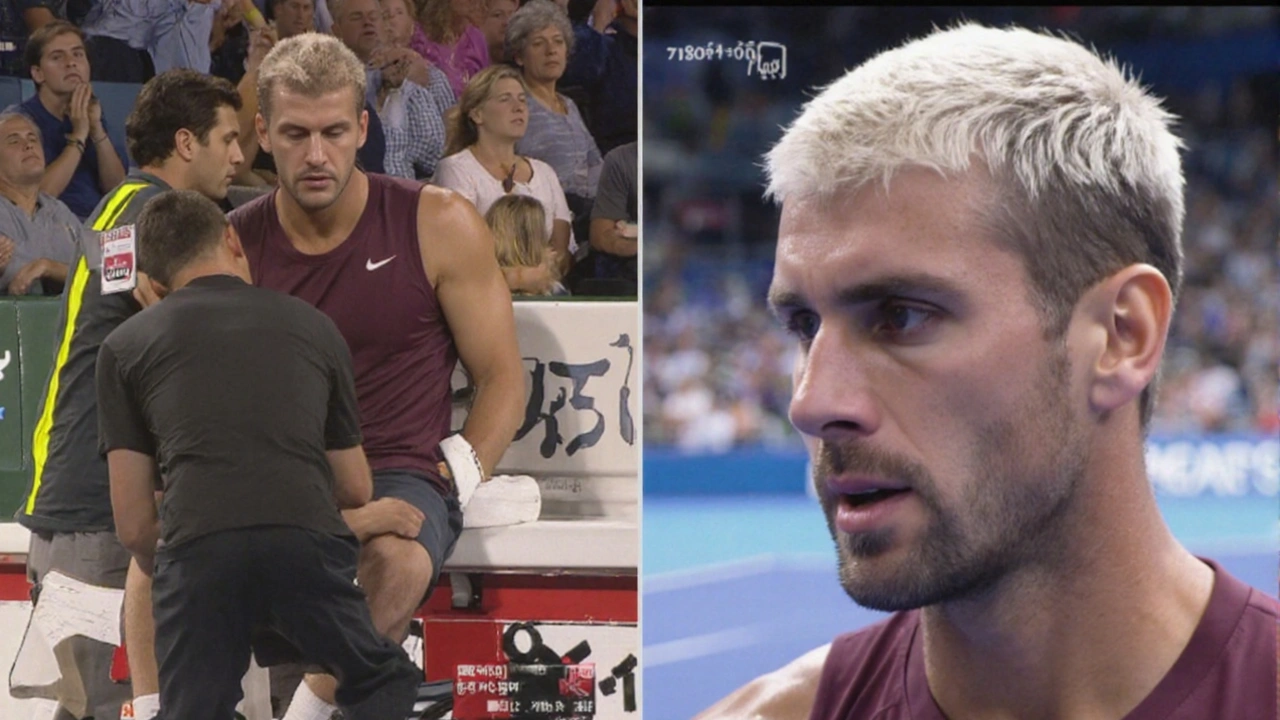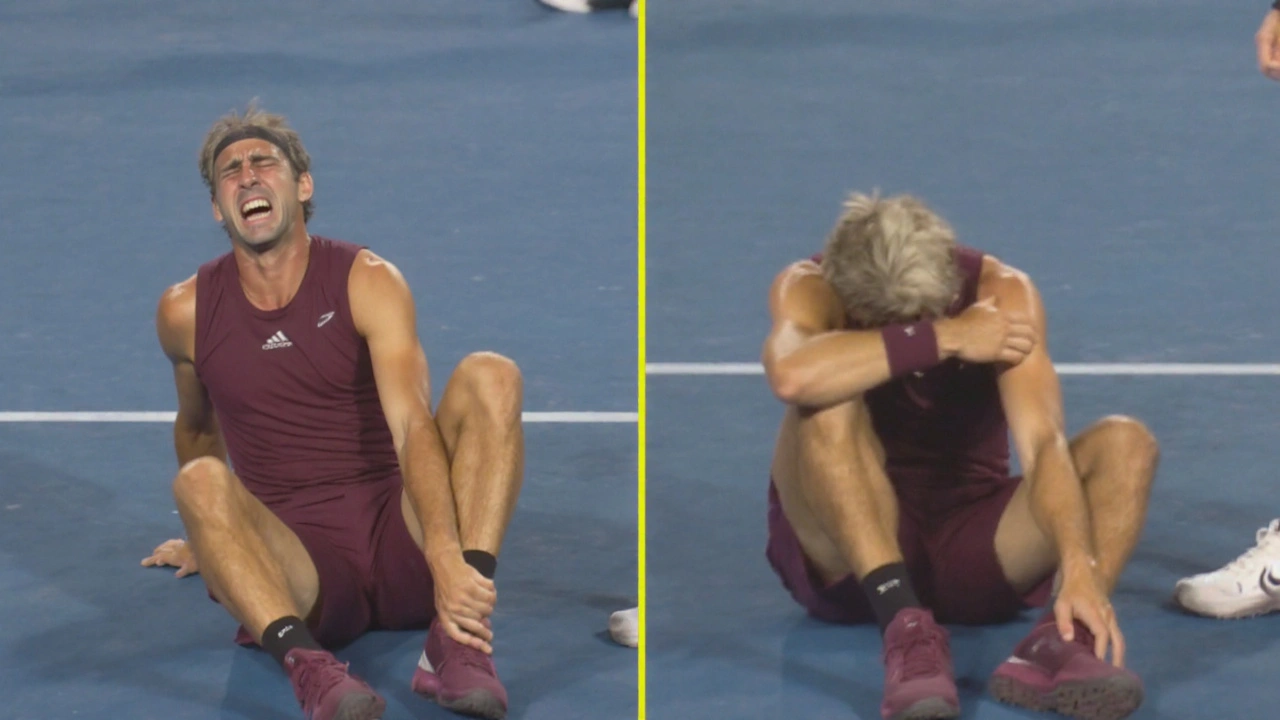What happened on court
Fans at the Ariake Coliseum were watching a fast‑moving rally when Alcaraz sprinted for a low ball. In the split second he lunged, a sharp jolt ripped through his right foot and his face twisted in pain. The world No.1 dropped straight onto the hard surface, gripping the injured area as a hushed silence fell over the arena.
Medical staff rushed in, but Alcaraz, visibly shaken, pushed himself back to his feet after a few minutes. He shook his head, took a deep breath and told the umpire he wanted to continue. The crowd cheered, half out of relief and half out of nervous excitement, as the Spaniard readied himself for the next point.
Remarkably, he kept playing. Each step looked tentative, and every serve seemed to remind him of the throbbing ache. Yet the 22‑year‑old’s shot selection stayed aggressive, and he managed to clinch the final set, sealing a win that left commentators both impressed and worried. The incident instantly went viral, with the clip looping across social media and sparking debates about player safety.

Aftermath and what’s next
Later that evening Alcaraz posted a short video on his social channels. He thanked fans for their support, said the pain was “manageable” and promised a full check‑up with his team of physiotherapists. He also hinted that the injury was likely a strain rather than a fracture, but admitted that he would monitor it closely over the next weeks.
Experts in tennis medicine have weighed in, noting that playing on a foot strain can lead to longer‑term issues if not treated properly. They recommend targeted rest, ice and a gradual return to full training. Alcaraz’s coach confirmed that the Spaniard would sit out at least one of the remaining Asian hard‑court tournaments to allow his foot to heal.
With the Asian swing still in full gear, Alcaraz’s schedule now looks like this:
- Skip the next week’s Shanghai Open to focus on recovery.
- Target a return at the Shenzhen Open in two weeks, pending medical clearance.
- Plan to be fully ready for the upcoming European clay‑court season, where he hopes to defend his titles.
The fallout from the Tokyo incident also reignited the rivalry conversation with Italy’s Jannik Sinner, who is currently playing the China Open. When asked why he chose to stay in Tokyo rather than follow Sinner, Alcaraz said the competition pushes him to improve and that he enjoys the challenge of facing the Italian in different conditions.
While the immediate concern is the foot, the broader tennis community is watching how the world No.1 balances ambition with health. The episode has reminded everyone that even the strongest athletes are vulnerable, and that a single misstep can change a season’s trajectory.
Carlos Alcaraz injury will likely be a talking point on the tour for weeks, as doctors, fans and fellow players gauge how quickly the Spaniard can get back to his dominant form without risking further damage.


Prince Raj
Alcaraz’s foot strain is a classic case of overloading kinetic chains during high‑intensity rallies. The stress on the plantar fascia spikes when you’re sprinting for low balls, and it’s no surprise the micro‑tear manifested now. He should definitely prioritize a controlled rehab protocol rather than brute‑forcing through the Asian swing. Otherwise we risk a cascade of secondary injuries.
Gopal Jaat
It is truly unfortunate to witness a top‑seed athlete succumb to such a sudden setback. The medical team’s swift intervention was commendable, and the crowd’s reaction reflected genuine concern. Nevertheless, the player’s determination to finish the match is admirable.
UJJAl GORAI
Seeing Alcariz stumble on the hard court is a stark reminder that elite performance walks a razor‑thin line between glory and injury. The biomechanics of a low‑ball sprint impose a shear force on the metatarsals that most players ignore until the pain becomes audible. In this case, the foot strain could easily evolve into a stress fracture if the inflammatory response is not meticulously managed. Medical literature suggests that early immobilization, followed by graduated load‑bearing, dramatically reduces the odds of chronic pathology. Alcaraz’s decision to push on, while admirable, might be driven more by a competitive ego than by sound physiological judgment. Fans love a warrior, yet the real heroics lie in knowing when to sit out and let the body heal. The video clip circulating on socials may fuel the myth that champions are invincible, which is simply not true. A single misstep, as seen in Tokyo, can cascade into missed Grand Slam points later in the season. The Spanish coach’s plan to skip Shanghai is a prudent move, aligning with evidence‑based recovery timelines. Moreover, the upcoming Shenzhen appearance should be approached with a conservative training load. If the foot recovers fully, the player can still dominate on the European clay, where the surface is gentler on the lower limbs. Conversely, any lingering weakness could be exploited by rivals like Sinner, who thrive on exploiting opponents’ fatigue. From a sports‑medicine perspective, the key metrics to monitor are swelling, gait symmetry, and plantar pressure distribution. Advanced imaging, such as MRI, can differentiate between a benign strain and a developing stress reaction. Ultimately, the balance between ambition and health will dictate whether this setback becomes a footnote or a turning point in his career.
Satpal Singh
The data from the match clearly shows a decrease in lateral movement efficiency after the injury. Monitoring his serve speed in upcoming tournaments will be essential.
Devendra Pandey
While the push for recovery is understandable, there’s a thin line between resilience and recklessness that shouldn’t be crossed.
manoj jadhav
Wow, what a turn of events, the foot injury is a serious concern, yet the player's determination never wanes, and the crowd's reaction is a mixture of awe and anxiety, indeed a testament to his willpower.
saurav kumar
He should take the advised rest and come back stronger.
Ashish Kumar
Indeed, the romanticized view of “playing through pain” does more harm than good. The medical team’s caution is the right call. Fans often overlook the long‑term damage in favor of short‑term spectacle. It’s better to see Alcaraz fully fit for the clay season than a limp champion. The narrative should shift from heroics to smart recovery.
Pinki Bhatia
I feel for Alcaraz and the team; injuries are heartbreaking for any athlete. Hopefully the rehab goes smoothly and he returns without lingering issues.
NARESH KUMAR
Ouch, that looks painful 😬
Purna Chandra
Yo, the foot saga is wild-just when you think the tour's heating up, bam, a twist and the world No.1’s in recovery mode. Guess the universe wants us to see a fresh champion rise, huh? Keep those memes coming, and let’s hope Alcaraz bounces back like a rubber ball on the clay.
Mohamed Rafi Mohamed Ansari
From a physio standpoint, the initial 48‑hour ice protocol combined with compression can reduce swelling dramatically. Afterwards, a gradual load‑bearing regimen, starting with stationary bike and progressing to light court drills, is recommended. Make sure to re‑evaluate gait mechanics before full match play.